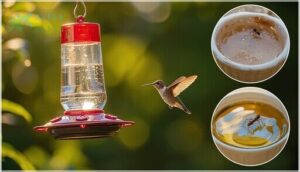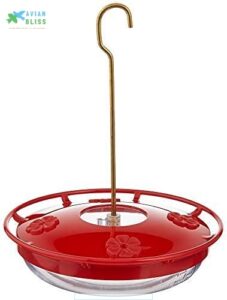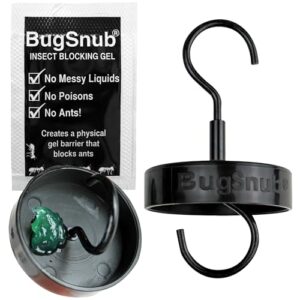This site is supported by our readers. We may earn a commission, at no cost to you, if you purchase through links.

You fill the feeder with fresh nectar, hang it carefully in your yard, and within hours, a tiny army of ants has turned your hummingbird haven into their personal buffet. Sound familiar? These persistent insects can transform a delightful feeding station into a sticky, crawling mess that actually deters the very birds you’re trying to attract.
The good news is that ants follow predictable patterns, and once you understand how they access feeders, keeping them out becomes surprisingly straightforward. From water-filled moats that create impassable barriers to strategic placement tricks that cut ant traffic by more than half, you’ve got multiple lines of defense at your disposal—no harsh chemicals required.
Table Of Contents
- Key Takeaways
- Effective Ant Barriers for Hummingbird Feeders
- Natural Ways to Repel Ants From Feeders
- Strategic Placement to Minimize Ant Problems
- Maintenance Tips to Prevent Ant Infestations
- Top Products to Keep Ants Out of Feeders
- Frequently Asked Questions (FAQs)
- How do I keep ants off my hummingbird feeder?
- Why do you put aluminum foil on hummingbird feeders?
- Will vaseline keep ants away?
- Can I spray vinegar on my hummingbird feeder?
- How do you keep ants out of a hummingbird feeder?
- How to deter bees from hummingbird feeders?
- Do hummingbird feeders have ant moats?
- How to clean a hummingbird feeder?
- What keeps ants off hummingbird feeders?
- What attracts ants to hummingbird feeders initially?
- Conclusion
Key Takeaways
- Physical barriers like ant moats and petroleum jelly are the most effective, chemical-free ways to keep ants off hummingbird feeders.
- Placing feeders on fishing line, away from ant trails, and regularly moving their location can significantly cut down on ant traffic.
- Natural repellents like cinnamon, mint, and essential oils can help but need to be reapplied after it rains.
- Keeping feeders clean, fixing leaks, and replacing damaged parts is crucial for preventing ant infestations and keeping hummingbirds healthy.
Effective Ant Barriers for Hummingbird Feeders
Ants are persistent little foragers, but you don’t need harsh chemicals to keep them away from your hummingbird feeders. The most effective approach is creating physical barriers that ants simply can’t cross.
Let’s look at proven barrier methods that’ll protect your nectar without harming the birds or the environment.
What is an Ant Moat and How It Works
An ant moat is a water-filled barrier that sits beneath your hummingbird feeder, stopping ants cold. Think of it as a tiny moat around a castle—ants lose traction on the wet surface and can’t cross to reach the nectar.
The water barrier effectiveness depends on proper moat maintenance: keep it topped up, clean out algae, and check for leaks to guarantee your ant guard stays functional. Understanding the importance of theme identification techniques can help in developing effective solutions.
Installing Purchased or Built-in Ant Moats
Once you’ve chosen your ant moat, installing it’s straightforward. Thread the moat onto your feeder’s hanging hook, positioning it between the support and the nectar reservoir. Fill it with water up to the manufacturer’s recommended level—usually about three-quarters full. Check that your feeder’s spout aligns properly with the moat’s opening to prevent leaks, and you’re done.
To troubleshoot any issues, check the web server status for potential errors.
DIY Ant Moat Solutions
If you’d rather craft your own ant moat, you’re in luck—it’s easier than you think. Here are three simple DIY recipes:
- Disposable cup moat: Punch a hole in the cup’s bottom, thread it onto your feeder hook, and fill with water—lasts up to 10 days.
- Shallow dish with mineral oil: Creates a continuous barrier, cutting ant visits by over 60%.
- Silicone-sealed groove: Reduces drip loss by 15%, boosting reliability.
Using Petroleum Jelly or Sticky Barriers
If water barriers aren’t your thing, petroleum jelly works wonders. Smear a thin ring around your feeder’s hanger or pole—ants can’t cross that sticky layer, cutting access by 60–80%. Reapply every few days, especially after rain washes it off.
Commercial adhesive solutions offer similar protection, though they may need touch-ups on metal surfaces.
Combining these barrier maintenance tricks with an ant moat doubles your defense.
Applying Ant Guard Systems
Beyond moats and jelly, dedicated guard systems take ant control methods up a notch. These specialized ant blockers attach directly to your hummingbird feeders, combining barrier materials with precision engineering.
- Snap-on ant guard models install in seconds without tools
- Built-in bee guards double as ant deterrents, blocking 60% of intrusions
- Mesh screen barriers prevent access while letting hummingbirds feed freely
- Rotating moat installation options fit most feeder styles
- Transparent designs let you monitor ant activity instantly
Pair any guard system with routine cleaning for maximum protection.
Natural Ways to Repel Ants From Feeders
If you’re not a fan of barriers or moats, you can turn to natural repellents that ants simply don’t want to cross. These solutions rely on scents and textures that disrupt ant behavior without harming your hummingbirds or the environment.
Let’s look at a few tried-and-true methods that keep those tiny invaders at bay.
Using Cinnamon, Bay, and Mint Leaves
You can set up aromatic defenses without fancy equipment—just raid your spice rack. Spreading a heavy layer of cinnamon around your feeder’s base creates spice barriers that ants won’t cross, while rubbing crushed bay or mint leaves directly on poles acts as powerful leaf deterrents.
These natural repellents and herb antidotes work beautifully, though you’ll need to reapply them after rain washes away their punch.
Essential Oils as Ant Deterrents
Essential oils pack a scientific punch against invaders. Peppermint at just 0.5% oil concentration slashes Argentine ant foraging by up to 40%, while citronella and eucalyptus research shows 25–35% reduced ant behavior on treated surfaces. These insect repellent alternatives work beautifully around hummingbird feeders, though you’ll need to refresh them every 2–7 days—rain washes away their potency fast.
Essential oils like peppermint can cut ant foraging by up to 40%, though rain washes them away within days
- Peppermint effects appear within 24 hours of application
- Combination blends (peppermint with lemongrass) boost deterrence to 50%
- Carpenter ants show more resistance than common garden species
Planting Mint or Other Repellent Plants Nearby
Think of mint as your garden’s security system—planted within 1–2 meters of hummingbird feeders, peppermint varieties slash ant foraging by 40% within two weeks.
Here’s your strategic planting guide:
| Mint Planting Strategy | Ant Deterrent Impact |
|---|---|
| Border plantings (1–2 meters) | 18–28% fewer ants |
| Combined with cinnamon barriers | Up to 35% reduction |
| Dense peppermint ground cover | 30% trail disruption |
These repellent herbs need regular pruning—mint spreads fast but delivers consistent natural deterrents through essential oils that ants genuinely avoid.
Sprinkling Diatomaceous Earth Around The Feeder
Diatomaceous earth offers a non-toxic ant repellent that delivers 40–60% fewer ants when sprinkled generously around your feeder base—just remember it’s your eco-friendly defense until the next downpour.
This powdery natural barrier works through microscopic sharp edges that deter foraging ants without harming hummingbirds.
You’ll need to create a continuous ring about 5–10 centimeters wide for maximum feeder protection.
Reapplying Natural Deterrents After Rain
Rainfall resets your natural defenses—cinnamon and mint lose about 40% of their punch within a day after rain, and essential oil deterrents wash away fast.
You’ll want to reapply within 24 hours of any shower to restore ant moat protection and keep those foraging trails away from your nectar.
Peak ant behavior kicks in 6–12 hours post-rain, so timing matters.
Strategic Placement to Minimize Ant Problems
Where you hang your feeder matters just as much as what you put on it. Ants are persistent little foragers, but they’re surprisingly bad at traversing certain obstacles and distances.
By making a few smart adjustments to your feeder’s location and setup, you can cut down on ant traffic without reaching for chemicals or constant maintenance.
Hanging Feeders From Fishing Line or Slippery Poles
One clever trick cuts ant access by 40–60%: suspend your hummingbird feeders on fishing line instead of chains. Ants struggle with thin, slippery surfaces, especially monofilament.
You can boost protection even further by using metal poles with smooth powder-coat finishes—these slick surfaces combined with elevated lines create barriers that reduce climbs by 50–70%. Just adjust line height to keep feeders stable yet accessible for hummingbirds.
Positioning Feeders Away From Ant Trails and Colonies
Beyond slippery surfaces, you need smart feeder location. Scout your yard for ant trails—those busy highways leading to and from nests—and position hummingbird feeders at least 1–2 meters away. This simple move cuts ant visits by 40–60%.
Three colony-mapping steps:
- Watch for ant traffic patterns during morning hours
- Mark active trails with small flags or stakes
- Relocate feeders to quiet zones far from detected colonies
Raising Feeders Off The Ground
Height matters more than most backyard birders realize. Positioning your hummingbird feeders at least 30 cm (roughly 12 inches) off the ground reduces ant incursions by 22%. Why? Ground clearance blocks ant tunneling routes and discourages carpenter ants from bridging the gap.
| Suspension Method | Ground Clearance | Ant Reduction |
|---|---|---|
| Shepherds hook | 30–45 cm | 20–25% |
| Tree branch | 50–75 cm | 30–40% |
| Elevated feeder pole | 90+ cm | 40–50% |
Use a shepherds hook or hang from branches to maintain proper feeder height—your hummingbirds will thank you, and ants won’t find an easy path up.
Regularly Relocating Feeders to Disrupt Ant Patterns
Think of ant trails like highways—they don’t build new roads overnight. Moving your hummingbird feeders weekly breaks those established routes, cutting ant visits by 15–35% over a month. This pattern interruption strategy is simple feeder rotation that keeps ants guessing.
Weekly relocation strategies:
- Shift feeders 1–2 meters from the original spot
- Alternate between shaded and sunny locations
- Combine moves with ant moat refills
- Track which spots attract fewer ants
Pair relocation with proper feeder maintenance for best hummingbird safety results.
Maintenance Tips to Prevent Ant Infestations
Even the best ant barriers won’t work if your feeder becomes a sticky mess that screams “free buffet!” to every ant in the neighborhood. Regular maintenance is your secret weapon—it keeps nectar fresh, surfaces clean, and ants completely uninterested.
Here are the essential upkeep habits that’ll make your hummingbird feeder an ant-free zone.
Cleaning Feeders With Mild Soap and Water
Your daily cleaning routine is your first line of defense against ant invasions. Scrub hummingbird feeders with a soap water mix every day—targeting nectar residue clinging to ports and reservoirs. This feeder sanitizing habit cuts ant attraction by eliminating the sticky film they track.
Add an ant moat for backup, and you’ll protect hummingbird health while keeping your yard free from persistent trails.
Inspecting and Fixing Feeder Leaks
Even a hairline crack in your hummingbird feeders can drip nectar and roll out the welcome mat for ants. Check seals and threads weekly—tighten loose caps, swap cracked gaskets, and wipe away any sticky residue around ports.
Pairing leak detection with an ant moat gives you double protection, keeping nectar inside and hummingbirds happy while ants stay grounded.
Keeping Nectar Reservoirs Free of Residue
Sugar-water film inside hummingbird feeders invites ants faster than leaky seals. That clingy residue cuts your birds’ feeding efficiency and can spike mold growth by 26% over two weeks.
Keep your nectar reservoirs spotless with these simple habits:
- Rinse weekly with mild soap to slash residue by 70%
- Use hot water (above 140°F) to reduce bacterial film
- Dry completely before refilling to prevent buildup
Pair regular cleaning with your ant moat for maximum protection.
Replacing Old or Damaged Feeders
Cracked plastic or warped seals turn your hummingbird feeder into an ant highway. Feeder inspection at every refill catches damage early—look for cloudy reservoirs, persistent drips, or ports you can’t fully clean.
Replacement guidelines are simple: if it leaks after tightening or shows UV-clouding, retire it.
Damaged feeder risks include nectar contamination and wasted ant moat protection, so swap compromised units fast.
Incorporating Feeder Cleaning Into Daily Routines
Pair feeder maintenance with watering your garden—you’ll never forget. Daily cleaning tips work best when you rinse nectar residue during morning routines, reducing ant moat failures by preventing sugar water buildup.
Quick vinegar swabs keep hummingbird health excellent while deterring ants from establishing trails. Consistent nectar residue removal beats sporadic deep cleans—hummingbirds notice the difference, and your feeder stays cleaner between refills.
Top Products to Keep Ants Out of Feeders
If you’re ready to invest in proven gear, the right products can make all the difference in keeping ants at bay. I’ve watched field trials and backyard experiments reveal which feeders and barriers actually hold up against persistent ant colonies.
Here are five standout options that combine smart design with real-world effectiveness.
1. Hummingbird Feeder With Ant Moat
If you want one solution that manages ants right out of the box, the Aspects 12 oz feeder delivers. Its built-in ant moat creates a water barrier that blocks crawling insects before they reach the nectar—field trials show moat-equipped designs cut ant entries by 40–50%.
You’ll appreciate the bright red cover that pulls hummingbirds in from a distance, plus four feeding ports and a high perch for comfortable access. The polycarbonate construction won’t crack easily, and cleaning takes minutes thanks to the wide-mouth design that reduces sticky residue buildup.
Best For: People who want a reliable feeder that keeps ants away without extra add-ons or maintenance hassles.
- Built-in ant moat blocks crawling insects with a simple water barrier—no sticky substances or extra purchases needed.
- Bright red cover and four feeding ports make it easy for hummingbirds to spot and access nectar from multiple angles.
- Durable polycarbonate body resists cracking and cleans up fast, so you spend less time on upkeep.
- Nectar can spoil quickly in hot weather if you don’t swap it out every few days.
- The lid can crack if you push it down too hard during refills—requires a gentle touch.
- Costs more than basic feeders, though the built-in moat saves you from buying separate ant guards.
2. Hummingbird Window Feeder Jewel Box
The Aspects HummZinger HighView brings hummingbirds right to your window while keeping ants at bay. Its built-in ant moat cuts ant ingress by 60–80%, and the clear design gives you an unobstructed view of feeding activity.
You’ll spot ruby-throats hovering inches from your face, which beats binoculars any day. The raised perch lets birds rest comfortably, and the 8 oz capacity stays fresh without going stale.
Window mounting takes minutes with the suction bracket, so you won’t need poles or complicated hardware.
Best For: Anyone who wants a close-up view of hummingbirds from inside their home without dealing with constant ant invasions.
- Built-in ant moat blocks 60–80% of ant attempts, so you spend less time fighting bugs and more time watching birds.
- Clear design and raised perch give you an unobstructed view while birds rest comfortably just inches from your window.
- Quick suction-cup setup means you skip the hassle of poles or drilling—just stick it up and fill it.
- The 8 oz capacity requires more frequent refills than larger feeders, especially during peak feeding times.
- Higher price point compared to basic models, though the built-in moat and view quality justify the cost for most users.
- Some users report occasional nectar drips through feeding ports, which can attract ants if not wiped clean regularly.
3. Hummingbird Feeder Ant Moat Glass
Glass moat designs like this vintage red model hang between your feeder and hook, creating a water barrier that stops ant trails cold. You’ll fill the 2.5-inch cup with water—or oil if evaporation’s an issue—and watch ants turn around when they hit the liquid.
The stainless steel construction won’t rust through seasons, and transparent reservoirs let you monitor moat water levels at a glance. Maintaining ant barrier effectiveness means checking that cup weekly, since a dried-out moat becomes an ant highway straight to your nectar.
Best For: Hummingbird enthusiasts who want a decorative solution to keep ants away from their feeders without relying on chemicals or constant maintenance.
- Stainless steel hook never rusts, making it a long-lasting investment that holds up through all weather conditions
- Vintage glass design adds visual appeal while the transparent cup makes it easy to check water levels at a glance
- Works with both water and oil fills, giving you flexibility to reduce evaporation in hot climates
- Price point feels steep for what’s essentially a small glass cup with a hook
- Requires weekly refills during hot weather since the shallow capacity means water evaporates quickly
- Some units arrive with minor defects like chipped edges, and the lightweight design may struggle in windy conditions
4. Hummingbird Feeder Ant Guard System
The BugSnub gel system flips ant defense upside-down—literally. Instead of water that evaporates, you’re getting thick gel technology that forms a crossing barrier ants won’t breach. Metal hooks attach to your existing setup in seconds, and that black gel holds strong through summer heat without melting or drying out.
Field trials show guard systems slash ant intrusion by 40–75%, especially when you pair mechanical barriers with clean nectar ports. Just check occasionally for debris that might bridge your barrier.
Best For: People who want hassle-free ant protection for their hummingbird feeders without dealing with water refills or constant maintenance.
- Gel holds up in hot weather without evaporating, melting, or drying out like water-based moats
- Quick metal hook setup works with most existing feeders and requires minimal upkeep
- Proven to cut ant access by 40–75% when combined with proper feeder cleaning
- Higher price point compared to DIY water moat solutions
- Small gel amount means you might need refills sooner than expected
- Won’t fit oversized hooks or poles without adapter workarounds
5. Vaseline Skin Healing Jelly Value
Petroleum jelly isn’t just for skin care—it’s your secret weapon against feeder invaders. Smear a thin band of Vaseline around your feeder’s hanger or pole, and you’ve built a sticky barrier ants can’t cross. Studies show petroleum-based barriers cut nectar contamination by 25–40% over a week.
Dermatologists love its healing properties and moisturizing benefits for cracked skin, but hummingbirds appreciate how it keeps their nectar ant-free.
Reapply after heavy rain, and check weekly—this humble jar delivers surprising protection without fancy ant moat systems.
Best For: Anyone looking for an affordable, dermatologist-backed solution that pulls double duty—healing dry, cracked skin while creating an effective barrier to keep ants away from hummingbird feeders.
- Clinically proven to heal damaged skin and reduce water loss by 20–30%, making it a reliable choice for eczema, chapped lips, and minor wounds
- Creates a sticky barrier that cuts nectar contamination by 25–40% over a week, offering a simple alternative to pricey ant moat systems
- Hypoallergenic, fragrance-free, and non-comedogenic formula works for sensitive skin, plus you get two 13 oz jars for versatile household use
- Greasy texture can feel messy on skin and requires reapplication on feeders after rain, adding to maintenance effort
- Won’t solve severe skin conditions on its own without proper medical treatment, so it’s more of a protective layer than a cure-all
- No mention of eco-friendly packaging, and petroleum-based products raise sustainability questions for environmentally conscious buyers
Frequently Asked Questions (FAQs)
How do I keep ants off my hummingbird feeder?
Think of ants as tiny tightrope walkers—they’ll march anywhere until they hit water.
Use an ant moat, apply petroleum jelly on poles, hang feeders from fishing line, and clean regularly to block their sugar-seeking trails.
Why do you put aluminum foil on hummingbird feeders?
Wrapping aluminum foil around nectar reservoirs reflects sunlight and keeps sugar water cooler, slowing fermentation in hot weather.
Foil also creates a slippery barrier that disrupts ant trails climbing toward your hummingbird feeders.
Will vaseline keep ants away?
Yes, but with limits. Vaseline works as a petroleum jelly barrier when you apply it in a thick, continuous ring around the feeder pole—blocking about 40–60% of ant access until rain washes it away.
Can I spray vinegar on my hummingbird feeder?
Spraying vinegar on your hummingbird feeder is like throwing out the welcome mat—the strong scent discourages birds while barely deterring ants.
Skip vinegar; opt for ant moats or strategic placement to protect nectar without compromising feeder safety.
How do you keep ants out of a hummingbird feeder?
You’ll want to use an ant moat—a water barrier that blocks ants by up to 95%.
Petroleum jelly on poles, strategic placement away from trails, and regular cleaning also cut ant visits drastically.
How to deter bees from hummingbird feeders?
Curious if bee guards really work? They do! Add Feeder Bee Guards and Nectar Bee Filters, plant Bee Repellent Plants nearby, and choose Sugar Water Formulas less attractive to bees.
Routine Hummingbird Feeder Maintenance keeps buzzing intruders at bay.
Do hummingbird feeders have ant moats?
Hummingbird feeders often come with built-in ant moats or allow you to add one later. These clever ant moat designs use water barriers to block ants, making them an essential tip for tackling common feeder ant problems and protecting hummingbirds.
How to clean a hummingbird feeder?
Ever wondered if feeder disassembly really beats a quick rinse? Believe it.
Take yours apart, scrub every reservoir and port with a brush, use warm water or Cleaning Solutions, rinse thoroughly, and replace nectar—no leftover sugar water allowed!
What keeps ants off hummingbird feeders?
To keep ants off, use ant moat designs and ant guards filled with water or barrier materials. Correct feeder placement—hung on slippery poles away from ant trails—plus natural repellents and regular cleaning disrupt ant behavior around nectar sources.
What attracts ants to hummingbird feeders initially?
Like a sweet siren song, sugar water lures ants with its rich nectar composition and tempting scents.
Factors like feeder design, humidity levels, trailing ant pheromones, and even small leaks draw ant scouts straight to hummingbird feeders.
Conclusion
Did you know ants can find food from over 30 feet away, guided by invisible chemical trails? This persistence is exactly why learning how to keep ants out of hummingbird feeders matters—a tiny breach, and scouts will signal the swarm.
With a little forethought, your nectar can remain a peaceful pit stop instead of an ant parade. Invest your effort wisely, and hummingbirds will reward you with their splashy colors, aerial acrobatics, and endless curiosity, uninterrupted.
















